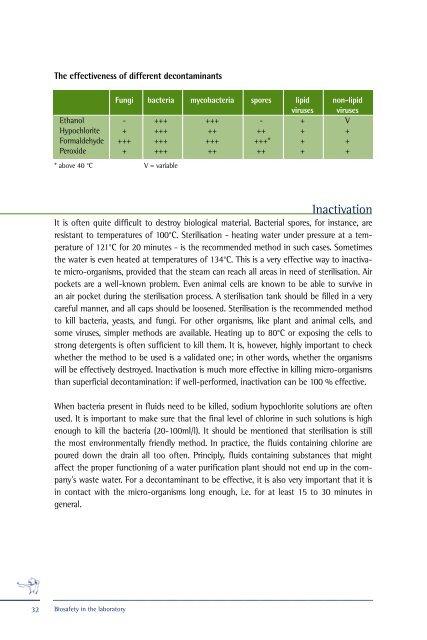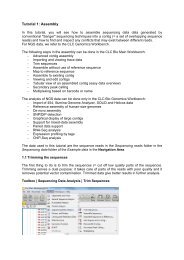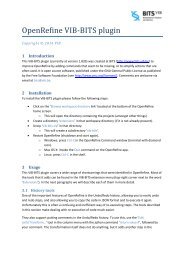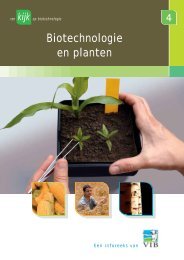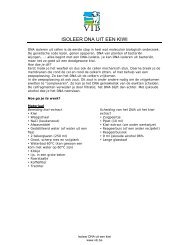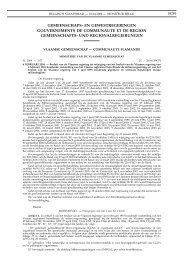Biosafety in the laboratory - VIB
Biosafety in the laboratory - VIB
Biosafety in the laboratory - VIB
Create successful ePaper yourself
Turn your PDF publications into a flip-book with our unique Google optimized e-Paper software.
The effectiveness of different decontam<strong>in</strong>ants<br />
Fungi bacteria mycobacteria spores lipid non-lipid<br />
viruses viruses<br />
Ethanol - +++ +++ - + V<br />
Hypochlorite + +++ ++ ++ + +<br />
Formaldehyde +++ +++ +++ +++* + +<br />
Peroxide + +++ ++ ++ + +<br />
* above 40 °C V = variable<br />
Inactivation<br />
It is often quite difficult to destroy biological material. Bacterial spores, for <strong>in</strong>stance, are<br />
resistant to temperatures of 100°C. Sterilisation - heat<strong>in</strong>g water under pressure at a temperature<br />
of 121°C for 20 m<strong>in</strong>utes - is <strong>the</strong> recommended method <strong>in</strong> such cases. Sometimes<br />
<strong>the</strong> water is even heated at temperatures of 134°C. This is a very effective way to <strong>in</strong>activate<br />
micro-organisms, provided that <strong>the</strong> steam can reach all areas <strong>in</strong> need of sterilisation. Air<br />
pockets are a well-known problem. Even animal cells are known to be able to survive <strong>in</strong><br />
an air pocket dur<strong>in</strong>g <strong>the</strong> sterilisation process. A sterilisation tank should be filled <strong>in</strong> a very<br />
careful manner, and all caps should be loosened. Sterilisation is <strong>the</strong> recommended method<br />
to kill bacteria, yeasts, and fungi. For o<strong>the</strong>r organisms, like plant and animal cells, and<br />
some viruses, simpler methods are available. Heat<strong>in</strong>g up to 80°C or expos<strong>in</strong>g <strong>the</strong> cells to<br />
strong detergents is often sufficient to kill <strong>the</strong>m. It is, however, highly important to check<br />
whe<strong>the</strong>r <strong>the</strong> method to be used is a validated one; <strong>in</strong> o<strong>the</strong>r words, whe<strong>the</strong>r <strong>the</strong> organisms<br />
will be effectively destroyed. Inactivation is much more effective <strong>in</strong> kill<strong>in</strong>g micro-organisms<br />
than superficial decontam<strong>in</strong>ation: if well-performed, <strong>in</strong>activation can be 100 % effective.<br />
When bacteria present <strong>in</strong> fluids need to be killed, sodium hypochlorite solutions are often<br />
used. It is important to make sure that <strong>the</strong> f<strong>in</strong>al level of chlor<strong>in</strong>e <strong>in</strong> such solutions is high<br />
enough to kill <strong>the</strong> bacteria (20-100ml/l). It should be mentioned that sterilisation is still<br />
<strong>the</strong> most environmentally friendly method. In practice, <strong>the</strong> fluids conta<strong>in</strong><strong>in</strong>g chlor<strong>in</strong>e are<br />
poured down <strong>the</strong> dra<strong>in</strong> all too often. Pr<strong>in</strong>ciply, fluids conta<strong>in</strong><strong>in</strong>g substances that might<br />
affect <strong>the</strong> proper function<strong>in</strong>g of a water purification plant should not end up <strong>in</strong> <strong>the</strong> company’s<br />
waste water. For a decontam<strong>in</strong>ant to be effective, it is also very important that it is<br />
<strong>in</strong> contact with <strong>the</strong> micro-organisms long enough, i.e. for at least 15 to 30 m<strong>in</strong>utes <strong>in</strong><br />
general.<br />
32<br />
<strong>Biosafety</strong> <strong>in</strong> <strong>the</strong> <strong>laboratory</strong>


